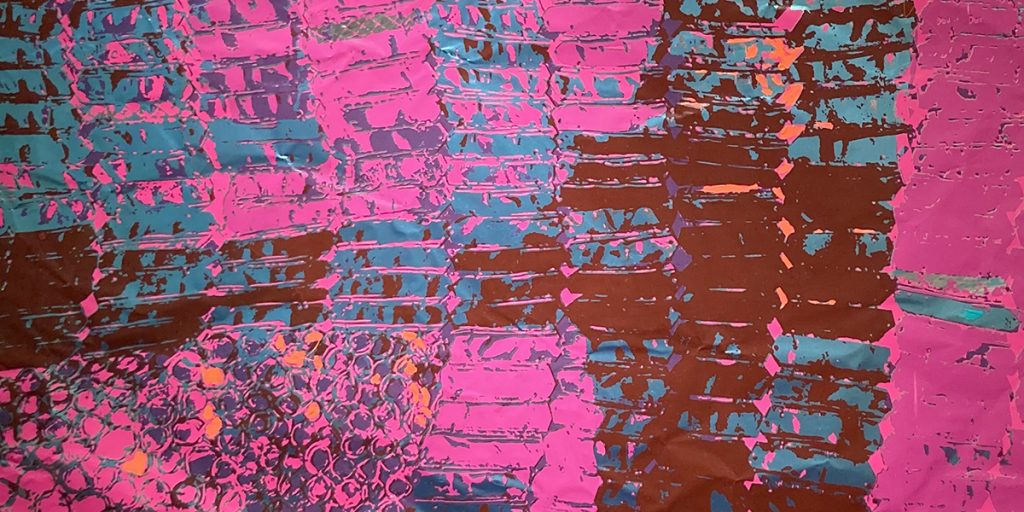
There are many ways to interpret a work of art, and the museum’s Label Talk series encourages visitors to reflect upon and voice their own interpretations of specific artworks, such as this stenciling and hand-painted enamel work by Ghanaian artist El Anatsui. Several members of the Middlebury community have offered their personal or professional reactions to this artwork, and those reactions are displayed adjacent to the work on the wall in the galleries. In publishing them here in this post as well, we hope these perspectives will inspire you to share your own responses to this work of art in the comments below.
We look forward to reading your responses.
El Anatsui has achieved global fame for his tapestry-like sculptures transform refuse into objects of deep contemplation. Using wire, Anatsui’s assistants join discarded caps and foil wrappers from liquor bottles into patterned blocks, which the artist then assembles into large, undulating wall hangings. The artist’s playful use of color, pattern, and texture in these abstract sculptures suggests his interest in the “non-fixity” of life—even as his use of detritus from alcohol bottles references the Atlantic slave trade.
Here, Anatsui combined scans of multiple sculptures into a digital collage, which printmakers translated into a silkscreen. After the printers passed pink, green, and black paint through this stencil, Anatsui bent the metal sheet and hand applied orange paint.

—Matthew Evan Taylor, Assistant Professor of Music
This piece reminds me of the richness and vibrancy of the Akan culture in Ghana. El Anatsui’s manipulation of hues throughout the piece sends a message that mimics the motto of Akan culture: to be vibrant and never hidden, no matter where one is situated.
Based on comparisons to the artist’s most famous sculptural works, one can deduce that the circles at the bottom of this piece originated from bottle caps. The story of Anatsui’s use of discarded bottle caps is immensely powerful. I hope every audience member researches this because it is, if I dare to even say, life changing. These circles make me think of today’s challenges in environmental justice. This piece takes an ongoing global issue and literally illuminates it on a frail but sturdy aluminum sheet.
Although El Anatsui’s use of purple and orange differs from the traditional red, gold, and green of the Kente fabric, this piece shares with Kente a core purpose of glorifying the power of color. It commands each one of us to stare a second longer, wondering where these circles originated and how they can illuminate and inform the future paths we take.
—Pearl Akoto ’24
Growing up in Ghana among four brothers, the colour pink was forced on me. Whether someone was buying us similar gifts or very different gifts, pink was always “the colour for Afua.” Having pink always made me feel insignificant because it was my least favourite colour and I always wanted blue, so I felt like no one cared about what I liked, wanted, or my opinions. Today, by contrast, the dominance of the pink in El Anatsui’s work makes me somehow feel seen and represented.
Likewise, having an artwork made by a Ghanaian artist placed in the college’s museum, as well as being asked to write a label for this piece, gives me a bit of hope. It helps me believe that both the college and the museum are actually making efforts to hear and represent people of colour and not just saying sweet things.
—Afua Amoa Bonsu ’23
Influenced by living in Africa and as a printmaker and collector of prints and textiles, I am particularly enamored with this work by El Anatsui. At first glance, I was surprised to discover this was a printed piece. The texture created by the layered colors on top of a crumpled aluminum substrate give the piece depth and dimension akin to a dappled leather hide or perhaps an abstract topographical map. With this piece El Anatsui creatively pushes the boundaries of what we typically imagine a limited edition print to be.
—Chris Murray, artist

The Heineken-cap journey
Down I look, from the top shelf,
A bent and tired-looking Olukuchi walks in,
I turn to my brother on the left,
To gossip about Olukuchi,
But my brother waves from the trash can,
He had opened the aspirin that Olukuchi’s pain needed,
I watched as Olukuchi chugged,
Glass after glass of Heineken ,
With his eyes closing after each chug,
And I saw his atrocities in his closed eyes,
His sick wife slowly dying in his bed,
His malnutritional children crying,
His bare famine-stricken farmland,
His rejected job applications,
His doom,
The rest of us,
End up in a trash can,
A truck picks us up in the morning,
Some of us fall on the streets and bushes,
The rest of us are dumped somewhere,
My new master picks us up,
Cleanse us off our filth and stink,
Hammers and pounds us,
Beautifully deforming us to unique patterns,
Then binds us together with copper wire,
Only when hanged on walls,
Do people see our beauty and grandeur,
We’re waste no more,
We’re flexible and malleable,
We’re unique and eye-catching,
Some of us are shipped overseas,
Hanged on their museums and walls,
To remind them of history,
The transatlantic slave trade,
Or perhaps colonialism,
We get tired of hanging outside,
Out in the sun, rain, wind, snow,
Our master scans us on aluminum,
To preserve our legacy,
Or perhaps he fears history will repeat itself,
All of us,
United by the thin copper wire,
Tell the story of Olukuchi,
To the people on the globe,
Because to understand the now,
They need connection to the past.
Vivian Syengo ‘25